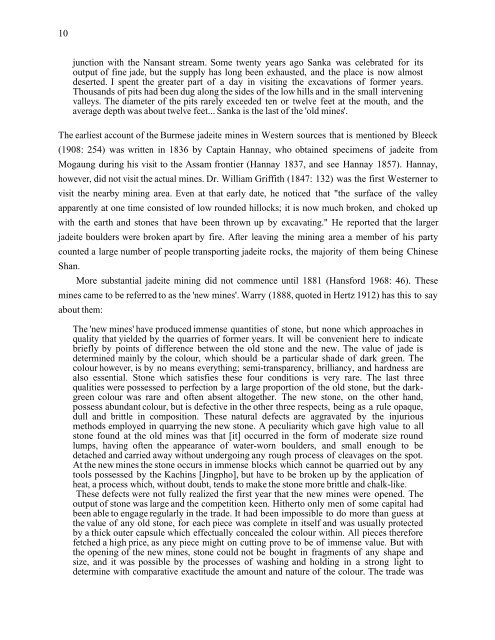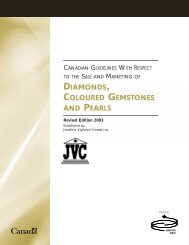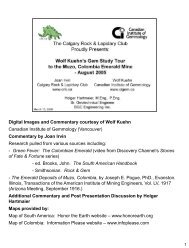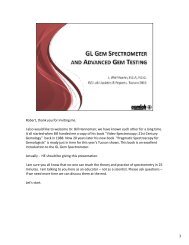JADEITE - Canadian Institute of Gemmology
JADEITE - Canadian Institute of Gemmology
JADEITE - Canadian Institute of Gemmology
You also want an ePaper? Increase the reach of your titles
YUMPU automatically turns print PDFs into web optimized ePapers that Google loves.
10<br />
junction with the Nansant stream. Some twenty years ago Sanka was celebrated for its<br />
output <strong>of</strong> fine jade, but the supply has long been exhausted, and the place is now almost<br />
deserted. I spent the greater part <strong>of</strong> a day in visiting the excavations <strong>of</strong> former years.<br />
Thousands <strong>of</strong> pits had been dug along the sides <strong>of</strong> the low hills and in the small intervening<br />
valleys. The diameter <strong>of</strong> the pits rarely exceeded ten or twelve feet at the mouth, and the<br />
average depth was about twelve feet... Sanka is the last <strong>of</strong> the 'old mines'.<br />
The earliest account <strong>of</strong> the Burmese jadeite mines in Western sources that is mentioned by Bleeck<br />
(1908: 254) was written in 1836 by Captain Hannay, who obtained specimens <strong>of</strong> jadeite from<br />
Mogaung during his visit to the Assam frontier (Hannay 1837, and see Hannay 1857). Hannay,<br />
however, did not visit the actual mines. Dr. William Griffith (1847: 132) was the first Westerner to<br />
visit the nearby mining area. Even at that early date, he noticed that "the surface <strong>of</strong> the valley<br />
apparently at one time consisted <strong>of</strong> low rounded hillocks; it is now much broken, and choked up<br />
with the earth and stones that have been thrown up by excavating." He reported that the larger<br />
jadeite boulders were broken apart by fire. After leaving the mining area a member <strong>of</strong> his party<br />
counted a large number <strong>of</strong> people transporting jadeite rocks, the majority <strong>of</strong> them being Chinese<br />
Shan.<br />
More substantial jadeite mining did not commence until 1881 (Hansford 1968: 46). These<br />
mines came to be referred to as the 'new mines'. Warry (1888, quoted in Hertz 1912) has this to say<br />
about them:<br />
The 'new mines' have produced immense quantities <strong>of</strong> stone, but none which approaches in<br />
quality that yielded by the quarries <strong>of</strong> former years. It will be convenient here to indicate<br />
briefly by points <strong>of</strong> difference between the old stone and the new. The value <strong>of</strong> jade is<br />
determined mainly by the colour, which should be a particular shade <strong>of</strong> dark green. The<br />
colour however, is by no means everything; semi-transparency, brilliancy, and hardness are<br />
also essential. Stone which satisfies these four conditions is very rare. The last three<br />
qualities were possessed to perfection by a large proportion <strong>of</strong> the old stone, but the darkgreen<br />
colour was rare and <strong>of</strong>ten absent altogether. The new stone, on the other hand,<br />
possess abundant colour, but is defective in the other three respects, being as a rule opaque,<br />
dull and brittle in composition. These natural defects are aggravated by the injurious<br />
methods employed in quarrying the new stone. A peculiarity which gave high value to all<br />
stone found at the old mines was that [it] occurred in the form <strong>of</strong> moderate size round<br />
lumps, having <strong>of</strong>ten the appearance <strong>of</strong> water-worn boulders, and small enough to be<br />
detached and carried away without undergoing any rough process <strong>of</strong> cleavages on the spot.<br />
At the new mines the stone occurs in immense blocks which cannot be quarried out by any<br />
tools possessed by the Kachins [Jingpho], but have to be broken up by the application <strong>of</strong><br />
heat, a process which, without doubt, tends to make the stone more brittle and chalk-like.<br />
These defects were not fully realized the first year that the new mines were opened. The<br />
output <strong>of</strong> stone was large and the competition keen. Hitherto only men <strong>of</strong> some capital had<br />
been able to engage regularly in the trade. It had been impossible to do more than guess at<br />
the value <strong>of</strong> any old stone, for each piece was complete in itself and was usually protected<br />
by a thick outer capsule which effectually concealed the colour within. All pieces therefore<br />
fetched a high price, as any piece might on cutting prove to be <strong>of</strong> immense value. But with<br />
the opening <strong>of</strong> the new mines, stone could not be bought in fragments <strong>of</strong> any shape and<br />
size, and it was possible by the processes <strong>of</strong> washing and holding in a strong light to<br />
determine with comparative exactitude the amount and nature <strong>of</strong> the colour. The trade was









